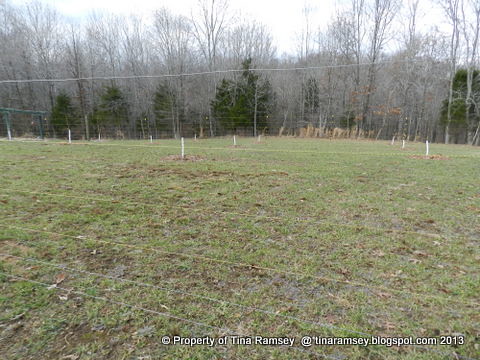
My posts are a little out of order as to how they have come about with my hands on gardening, but that is fine. It all works out in the end. I thought I'd share a new arena in my gardening with you all today. I have never seriously considered growing fruit for eating except for small fruits like blueberries, blackberries, raspberries, and strawberries. Well, with the addition of our land, now our little farm, Mr. Fix-it and I are very serious about growing our own food. And, by judging by the number of trees we planted we may be growing enough food for all of our families and then some. That is a great thing because orchards are not an easy thing to manage and be successful at. If I can successfully grow enough food for all of my family then that is all the better because I am in a good position to provide both labor and knowledge about growing fruit that the rest of my family might not have the time to work on. Mr. Fix-it and I are really good partners in our life. But when it comes to plants I supply the know how (after reading multiple books and learning hands on) and I also supply the labor in our team of two! Occasionally he helps out but with growing things that is pretty much my purview.
The picture above shows our newly planted orchard. I used the modified diamond planting method. Which is basically my trees planted in rows with adjacent rows offset half the distance. Even with 60 acres we don't have a lot of room to plant so I had to be frugal with my space. Our fenced orchard area is about 200'x80'. That is the entire fenced area which includes three beds of daylillies, one bed of blueberries, one bed of quince, a bed of raspberries and blackberries, and the grape arbor. When I take out all of that the orchard area we have allotted for the fruit trees actually is about 120'x80'. This is nearly all of the area pictured in the above photograph. Before we got to the point of planting the orchard we had already had a soil test, seeded 100 pounds of fescue, and limed the entire area with about 400 pounds of pelletized lime. This was vital to us because most fruit trees need a pH of about 6-7 and our pH was rather low. Additionally, I plan to mow the orchard floor and fescue works best for me. The area is now nice and green and all is doing well.
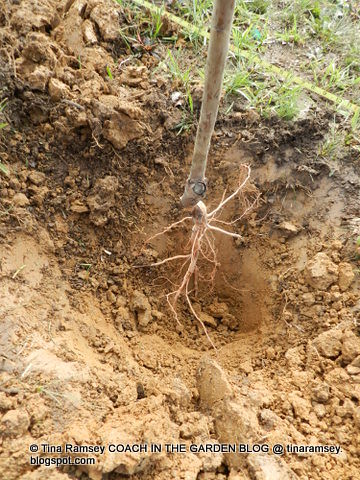
Our trees arrived about the third week of November. They were scheduled to arrive earlier but because I was out of town I asked Stark Bros. to please delay the shipment by one week. It wound up they were also delayed another week by other factors. That actually really worked out quite well for us-other than planting in the cold and the snow.
I ordered almost all of the trees, which are actually grafted whips (basically a twig that has been grafted on rootstock and pruned to a single leader about 5/8" of an inch diameter and about three feet tall) from Stark Bros. I really liked Stark Bros because the trees were all healthy, well marked and packaged, and arrived in good condition. Although I have not ordered a lot of fruit trees from other companies I can say I had a great experience with Stark Bros and have already ordered from them again.
I spent countless hours researching varieties that would work well for my growing conditions and area. Countless hours totaling over 40 but probably more like 100 hours. These hours involved some practical experience I had with a client who has an established orchard, as well as researching disease resistance of the various cultivars. Disease and pest resistance are top priorities for me in my garden. Common diseases of fruit trees we see in Tennessee include: fire blight, apple scab, cedar apple rust, powdery mildew, all sorts of rots, rusts, and various other diseases. My goal was to select trees that are noted to show the most resistance to the most amount of these diseases and fungi. Other people might reasonably choose fruit trees based on taste alone. While taste is always important my reasoning is that you can't have great taste if you can't reasonably grow the fruit, hence my focus on good disease and other problem resistance. I have found that the trees offered in nurseries locally are not always the most resistant trees to these problems. Once I found the correct trees I had to also choose their pollinators. Geez, the job was never ending. Despite all of this research I have since learned even more things about fruit trees via a few books specifically on growing fruit trees that I did not know. For instance, did you know sweet cherry trees grow twice as big as tart cherries? I just recently found that out. I am lucky that my spacing for the cherry trees should accommodate the two types easily no matter what. I hope!! Are you dying to hear the cultivars? Okay, here they are:
Pears
Bartlett (Traditional pear)
Kieffer (Oriental pear)
Moonglow (Traditional pear and pollinator)
Note: All pears were purchased locally and planted from plant pots. These pear trees were well rooted and established in the orchard back in August. I have spent time pruning them only.
Plums
Earliblue-Prune
Gold (Impulse purchase locally purchased and planted from a pot-not bareroot)
Methley
Starking Delicious Plum
Apples
Crimson Crisp
Enterprise
Golden Delicious (Good pollinator)
Gold Rush
Peaches
Early White
Intrepid
Redhaven
Cherries
Balaton (Tart)
Emperor (Sweet)
Montmorency (Tart)
Starkrimson (Sweet)
Pawpaws
KSU
Overleese
Sunflower
Note: All pawpaw varieties were purchased from Hidden Springs Nursery located in Tennessee. I had seen a segment on Volunteer Gardener about this nursery and thought I'd give it a try since it was local. Another plug for Hidden Springs Nursery is the fact that Kentucky State University (the authority on pawpaws) recommends sources for purchasing pawpaws and Hidden Springs was one of many nurseries. I was quite happy with my pawpaw whips. The graft points were all good and the whips were and still are, green!! The directions that came with the pawpaws were clear and simple to understand too. They included information you had to protect these whips from sun for the first few years or so. I'll show you my answer to this problem since the pawpaws are planted in full sun in the orchard.
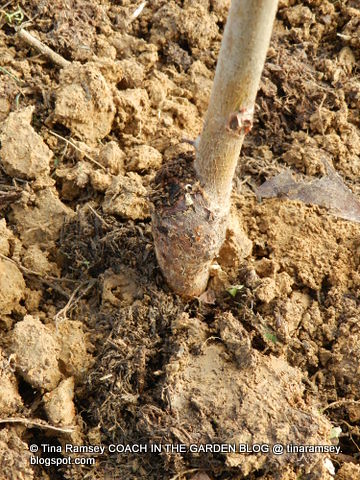
Planting the whips was more entailed than I had expected. I knew that the spacing of the trees had to be about 20-25' because all of my trees are semi-dwarf and are expected to remain about 10-20' tall and wide. Setting up the rows keeping everything straight meant getting out the compass to make sure the trees were on the same heading (240 degrees for the rows and 330 degrees for the columns) and that the spacing was all adequate. You would think bare root whips would be easy to plant but I think they took more time than planting potted trees! I had to dig BIG holes. The holes all wound up being about two feet deep and two feet wide. I amended the soil with a bit of lime, rabbit droppings, greensand, and compost. I set the whips in there, spread out the roots and backfilled taking care to make sure there were no air pockets. I then watered the whips. A lot of this work was mostly done in a sleet and snow storm. I'll never forget it. Fortunately, on this day during the snow and sleet it was not as cold as it could be because there was no wind blowing. Additionally, hubby and I were dressed quite warmly in layers. He was busy working on part II of this post-protecting the orchard while I planted the whips.
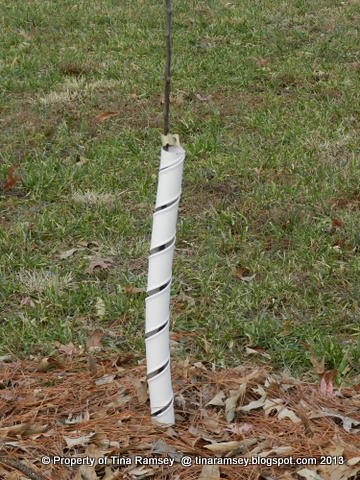
I have never been a fan of painting tree trunks but when I read that rabbits like to gnaw on fruit tree bark I thought these flexible white PVC wraps would be a good idea. I really like them too. They will not protect the whips from voles but so far we are doing good in the pest area-rabbits, voles, and deer have not been a major problem. Thank goodness because there are tons of deer on our land and they love the newly planted plants-including fruit trees in the summer (they ate all of the leaves from the 'Gold' plum but not from the pears), and they also ate the daylilies. Once I noticed the daylilies were being nibbled I though we might as well fence off that part of the field as well as the fruit trees because it is all in one area in the field. The only area we did not fence off was the wildflower field. A post on that will be coming soon. I do not think gardening should be stressful if we can help it. Dealing with deer can be stressful so I prefer to take passive measures to deal with the stress and problem of deer. To protect the orchard area we knew we would have to go with an electric fence and we are quite happy with the results.
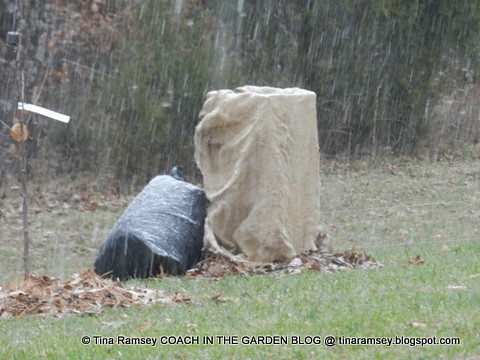
This is one of the three pawpaw shelters to shade the whips from the sun for the next few years. I had originally planted these whips 11' on center but found another source that said they needed to be planted 15' on center. I dug up the whips and replanted them. I hate admitting that because I said I would move or plant things only once but I have already had to dig up quite a few things and plant elsewhere. Sigh. I do also have two pawpaw trees that are pot grown. They are the species type and not grafted. They are about seven feet tall and will make beautiful shade trees at some point. I wish I had a picture of a mature pawpaw grown in sun but you can Google it if you'd like to see what they look like. The leaves of pawpaws are rather large and shaped like hickory leaves. The shape of the tree is pyramidial and the trees are quite dense. I am very excited about my two new pawpaws I purchased from a local nursery (Bates) at their 50% off end of season sale! I plan on placing my additional two pawpaws in front of the house once the house is done. Right next to the pawpaws (in the orchard) we will be planting fig trees. Right now we have five fig trees of different cultivars. They are all either in the garage, the greenhouse, or under the house for the winter. Fig trees are not reliably cold hardy in my area. I decided to wait until the spring to plant them in the orchard. This way the figs will have all summer to develop and establish good roots to hopefully be prepared for the winter next year.

Okay, so here I am with one of the whips. Can you see the roots? They spread pretty far and I had to be careful of them. The grafted point was very visible and instructions that came with the whips said to be sure to not cover the graft union. I tried to face all graft unions to the north for uniformity and made sure they were not buried.
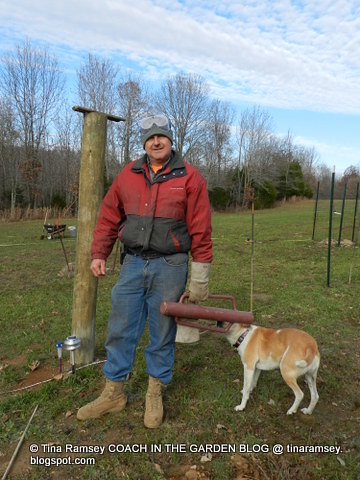
While I was working on planting the whips Mr. Fix-it's job was to install the electric fencing. Right next to Mr. Fix-it you might note the wooden post. This is the end of the orchard proper but because we decided to extend the electric fence all the way down the field to protect the small fruits, he had to do a lot of extra work by adding more poles. The sweet little dog next to Mr. Fix-it is our little Buttercup. She belongs to a neighbor but just loves us and spends all of her time with us when we are on the farm. She does have a good home but just likes the attention she gets from us. We are good with that because she is a doll and very good with both people and other dogs. She does like to chase deer tho. We don't appreciate that. She does not chase them long--just long enough to let them know she is boss so they had better move. We worry she may get shot one day but our land is posted so perhaps that won't happen if people are respectful and smart. So far she is a savvy dog who survives lots of diverse conditions--including running through glass and trash in the woods and chasing cars. This is not what our dogs will be allowed to do when we move out there just for the record.
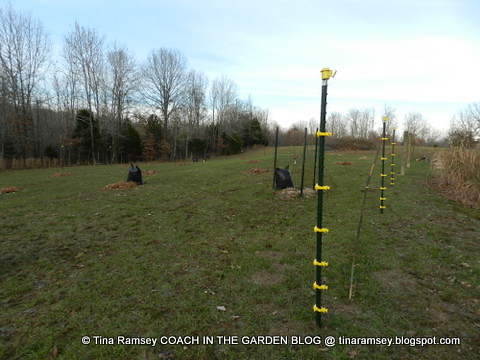
Our electric fence is six feet tall. That meant the pickets (T-bars) had to be eight footers. Driving them into the ground took a lot of work on Mr. Fix-it's part. For some reason he was quite optimistic that he could install the fence in one day. Haha, it took several days to finally complete it. Once it was completed he tested it with the solar charger we purchased. The solar charger said it was good for several miles and since the total amount of electric fence (all seven rows from just above the ground to the top of the pole) all the way around orchard was just under one mile we figured the charger would work. Not! The charger was so weak we could stand there with our hand on the fence. Don't make the same mistake we did with electric fence chargers. Just because they say they will do several miles you also have to look at the type of varmints you wish to keep out. We want to deter: deer, raccoons, skunks, possums, foxes, dogs, and perhaps people. That meant we needed a strong charger. The solar one only put out 2000 volts. None of the available chargers they had at the local farm stores would work. We had to turn to the Internet for a stronger charger. We mostly used Zareba fence products and turned to their website for a great deal of good information and Zareba is also who we purchased our more powerful charger from-at a lower price than the less powerful one. They actually spell it out on how to install a fence that will do the job no matter what you wish to keep in or out.
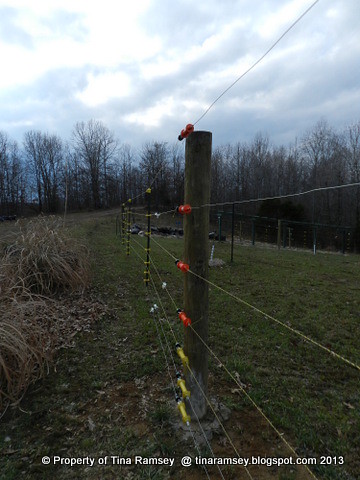
Zareba recommends seven lines of charged fencing up to six feet tall to keep out deer. There is actually specific spacing for each line as well. The website will help you to plan all the materials you need in a fairly easy manner if you happen to be a novice at electric fence installations. Fortunately for the most part we got it right other than the charger. We wound up buying a 25 mile battery operated charger for our fence. It puts out 7000 volts and no, you do not want to touch it! The above picture shows our drive through gate into the orchard. This side worked well with spacing but the other side was too close to the beds. I could not get a mower around the beds to mow the rows so Mr. Fix-it is in the process of moving the T-bars our about five feet so I can access the paths between the beds. Poor planning on my part as neither he nor I thought about mowing when he put in the fence. You live and learn I guess. We definitely learned.
Right now there is no charger hooked up to the fence and it seems to be doing well keeping the deer out. I have not noted any damage to the trees or plants inside of the fence. We need to build a storage a cabinet for our charger and its accompanying battery. That is my next project. Once that cabinet is built and we are able to secure it with a padlock and are out at the land more often, we'll then put the charger in place. The area is not secure and although we don't anticipate problems one can never be too sure that things might not grow legs and walk away. Additionally, the trees are all dormant so I really don't think they are that attractive to deer right now. There is no fruit or greenery that may attract smaller varmints either so we feel good about not charging the fence as of yet.
One good idea I had about the orchard is to put the chickens and bees in the orchard. I reason that the same electric fence that will protect the fruit will also protect the chickens, bees, and honey from all sorts of creatures who may wish to eat them. Solving two problems with one fence was a bonus! There is plenty of room in the orchard for the chicken coop and bee hives once I take the plunge. The chickens are a must once we get the chance to move the coop and kennel out there. I also think they'll do a good job keeping pests like ticks and chiggers in the orchard down--as long as I can keep them safe from hawks. I'll work on that later.
Wow, this is a long post, as always. I'm not sure how they get this way but most of my posts are informational. It is where my passions lie--with learning. I learn from words so think that perhaps others might learn from words as well. A lot of the sites I research don't use a lot of words--unless they are pdf file sites from educational institutes--and I am left coming away with more questions then before I started the research. I like to put a lot of info into my posts because in a few months I promise you I will have probably forgotten what I did so the words are actually all for me....
in the garden....
Your post may be long, but it is very informative and will be of help to anyone who wishes to do what you two are doing.
ReplyDeleteWhat a lot of work, but it will be well worth it when you are harvesting the goodies.
Have a great weekend ~ FlowerLady
Oh my! Somehow Tina, I think you should bottle and sell your and Mr. Fix It's energy. What a project. I do love Starks fruit trees and other things and one time a few years ago we took a fall down the river trip all the way to Louisiana, Missouri. Stayed at a nice B and B who proprietress told me that their big local nursery, which turn out to be Stark Bros. was having a big end of the season clearance. So we checked it out and sure enough they were practically giving away the shrubs and trees Ninety percent off so I bought several hundred dollars worth of stuff for our landscape.......:)
ReplyDeleteEvery time I visit, Tina, I am so impressed with all you have accomplished. Moving all your perennials seemed like such an overwhelming task, but planting an orchard and fencing it all in is quite a project, too. I'm curious to see your pawpaw trees when they mature--did you plant them for the fruit or for ornamental value? I've never eaten a pawpaw, but I know the tree is host for a specific butterfly (forgotten which one now), and I've often thought I'd like to have one tree for this reason.
ReplyDeleteI hope you had a chance to relax a little in the past week and had a very Merry Christmas. Wishing you the best in the New Year!
I've done a lot of things in sleet and snow but never dreamed of planting trees! Our sleet and snow usually comes with a lot of wind though. That would make a difference. What a fence. You are prepared. I sure hope all your fruit trees take to their new home. Do you do a lot of canning? I'm picturing rows of jars with fruit in them! You property continues to come together for you. You are a great project manager even if you did have to replant a few things! Be well!!!!
ReplyDeleteWow Tina...that is quite the fruit orchard. So impressive. I have always wanted my own but circumstances never happened....so I will live vicariously through you and watch your yummy fruit grow.
ReplyDeleteI think you have a Gardening Addiction Girl! LOL, I know you are passionate about gardening and all but in the rain and sleet and freezing temps? You are my Garden Hero! One day, you will have a wonderful farm in place.....
ReplyDelete